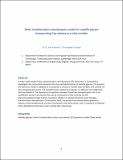Shear transformation zone dynamics model for metallic glasses incorporating free volume as a state variable
Author(s)
Li, L.; Homer, E. R.; Schuh, Christopher A.
DownloadFVSTZ-Acta13.pdf (2.626Mb)
PUBLISHER_CC
Publisher with Creative Commons License
Creative Commons Attribution
Terms of use
Metadata
Show full item recordAbstract
A mesoscale model, shear transformation zone dynamics (STZ dynamics), is employed to investigate the connections between the structure and deformation of metallic glasses. The present STZ dynamics model is adapted to incorporate a structure-related state variable, and evolves via two competing processes: STZ activation, which creates free volume, vs. diffusive rearrangement, which annihilates it. The dynamical competition between these two processes gives rise to an equilibrium excess free volume that can be connected to flow viscosity via the phenomenological Vogel–Fulcher–Tammann relation in relaxed structures near the glass transition temperature. On the other hand, the excess free volume allows glasses to deform at low temperatures via shear localization into shear bands, even in the presence of internal stress distributions that arise upon cooling after processing.
Date issued
2013-03Department
Massachusetts Institute of Technology. Department of Materials Science and EngineeringJournal
Acta Materialia
Publisher
Elsevier
Citation
Li, L., E.R. Homer, and C.A. Schuh. “Shear Transformation Zone Dynamics Model for Metallic Glasses Incorporating Free Volume as a State Variable.” Acta Materialia 61, no. 9 (May 2013): 3347–3359.
Version: Author's final manuscript
ISSN
13596454
1873-2453